Whether you’re looking for an invigorating start to your day or a relaxing escape in the evening, a great shower can make all the difference. With so many types of showers available to suit different styles, preferences, and budgets, choosing the right one can feel overwhelming. In this article, we’ll focus on thermostatic showers - what they are, how they work, and why they’re a smart choice for a safer, more comfortable showering experience.
In this article you will:
- Learn what a thermostatic shower is and why they are different from a mixer shower and electric showers.
- Understand the role of the thermostatic shower valve and the different types available.
- Enjoy our summary of thermostatic shower benefits.
- Learn the process our professional plumbers would follow to install a thermostatic shower valve successfully and safely.
- Gain access to our detailed guide on how a thermostatic shower works.
What Is A Thermostatic Shower?
A thermostatic shower is a type of shower that automatically keeps the water at a steady temperature, so you don’t have to fiddle with separate hot and cold taps to get it just right. Instead, it has a single control with a temperature scale, and the built-in thermostat does all the hard work for you. It constantly mixes the right amount of hot and cold water to maintain your chosen temperature, even if there are sudden changes in water supply.
For example, if you’re in the shower and someone turns on the hot tap in the kitchen, the shower won’t suddenly blast you with freezing water. The thermostat reacts by adjusting the cold-water flow to keep things stable. In reality, there can be a slight delay, and it’s not always 100% perfect, but overall, it makes for a much more comfortable and hassle-free shower experience!
How Do Thermostatic
Showers Work?
Inside the shower valve, there’s a special component called a wax capsule. As the hot and cold water flows over it, this wax expands or contracts depending on the temperature. When it reacts, it moves a piston, which automatically adjusts the balance of hot and cold water. This means if there’s a sudden drop in pressure - like when someone flushes a toilet - the shower instantly compensates to keep your water temperature steady.
No more surprise blasts of icy or scalding water - just a perfectly balanced, comfortable shower every time!
How Is A Thermostatic Shower
Different From Mixer Showers?
Thermostatic showers are much easier to use compared to a standard bath shower mixer. Let’s be honest - bath shower mixers can be a bit of a pain, can’t they? You’re constantly tweaking the hot and cold taps to get the temperature just right, and even when you do, it can suddenly change - too hot one second, freezing cold the next.
With a thermostatic shower, you don’t have to worry about that. It keeps the water at a steady temperature, adjusting automatically if there’s a change in water flow elsewhere in the house. If you're thinking of replacing a bath shower mixer, it’s good to know that thermostatic versions exist - not just for shower valves but for bath shower mixers too. In fact, most new shower valves these days are thermostatic, whereas manual ones are becoming less common. That said, you’ll still find plenty of manual bath shower mixers on the market, so it’s worth checking before you buy!
We recently replaced this broken bath shower mixer tap for a new Grohe Thermostatic Bath Shower Mixer complete with a new multi-spray head and hose!
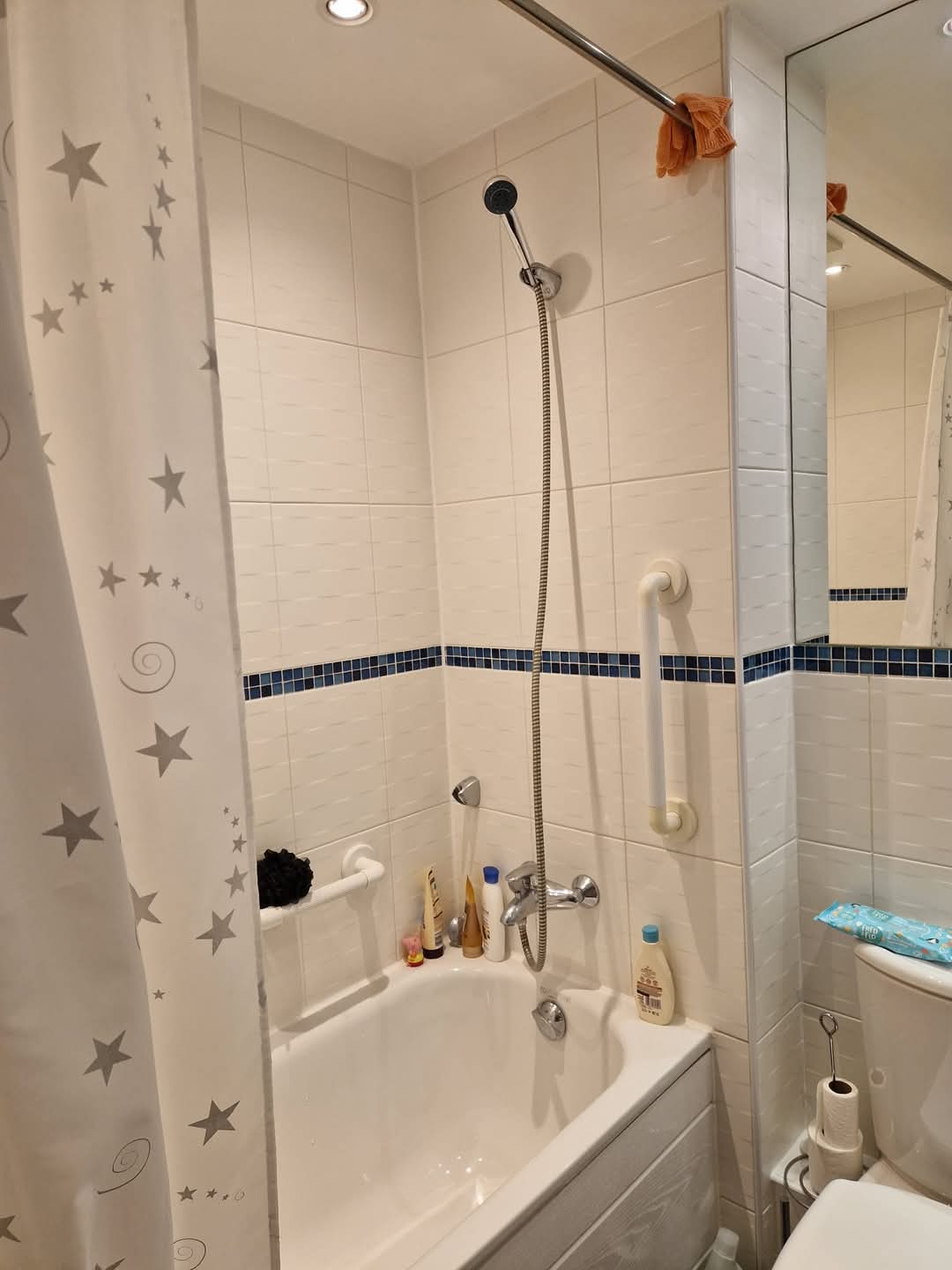

How Is A Thermostatic Shower
Different From Electric Showers?
Whilst they look similar, thermostatic showers and electric showers work in completely different ways.
A thermostatic shower takes pre-heated water from your hot water system (like a boiler or hot water tank) and mixes it with cold water to keep the temperature steady. It’s great because it automatically adjusts if someone uses water elsewhere in the house, preventing sudden blasts of hot or cold water.
An electric shower, on the other hand, doesn’t rely on your home’s hot water supply at all. Instead, it heats cold mains water on demand using an internal heating element - just like a kettle. This means even if your boiler breaks down, you’ll still have hot water for a shower! However, because it heats the water instantly, electric showers usually have lower water pressure compared to thermostatic showers, unless you go for a pumped model.
In short, thermostatic showers need a hot water supply and keep the temperature steady, while electric showers heat cold water on demand and work independently of your boiler.
Thermostatic Shower Valves
Shower valves are the heart of a reliable thermostatic shower. They are the crucial component that not only mixes hot and cold water to give you the perfect temperature, but they also react instantly to any changes in water supply. This valve is the clever bit of engineering which makes thermostatic shoers so reliable and easy to control.
One of the biggest perks? Safety. If the cold-water supply suddenly cuts out, the valve will shut off immediately—so no risk of being scalded by a blast of hot water! This built-in protection sets thermostatic showers apart from other types.
And don’t worry about finding one that suits your bathroom style - there are plenty of thermostatic shower valve designs to choose from:
- Bar Valve: A slimline and compact option, ideal for small bathrooms. Easy to install and budget-friendly, bar valves come in various finishes to match your décor.
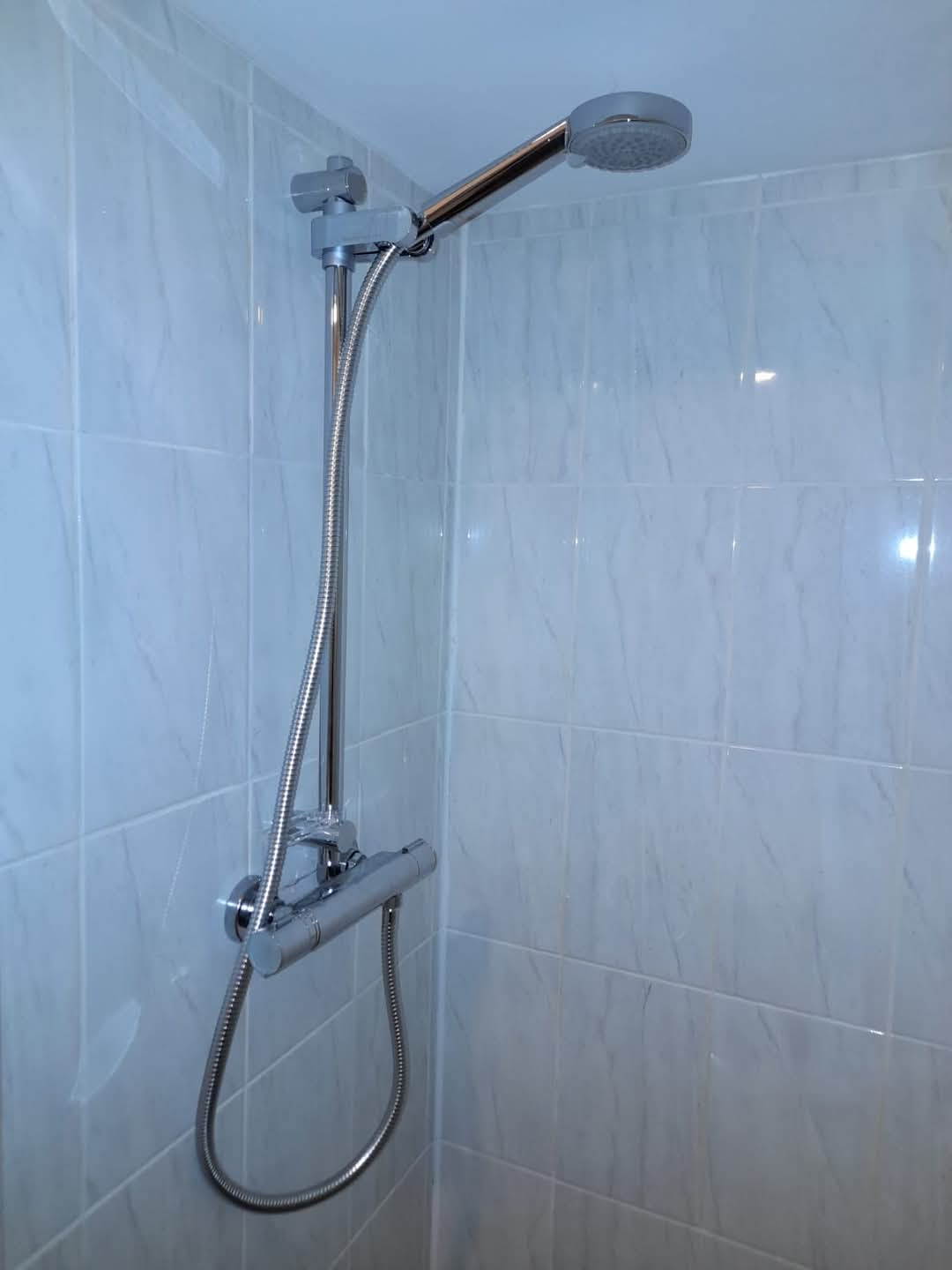
Aqualisa Bar-Type Thermostatic Shower Valve
- Concealed Valve: The go-to for a sleek, minimalist look. All the plumbing is hidden behind a stylish plate or even inside the wall, leaving just the controls, riser, and showerhead on display. Less clutter, more style!
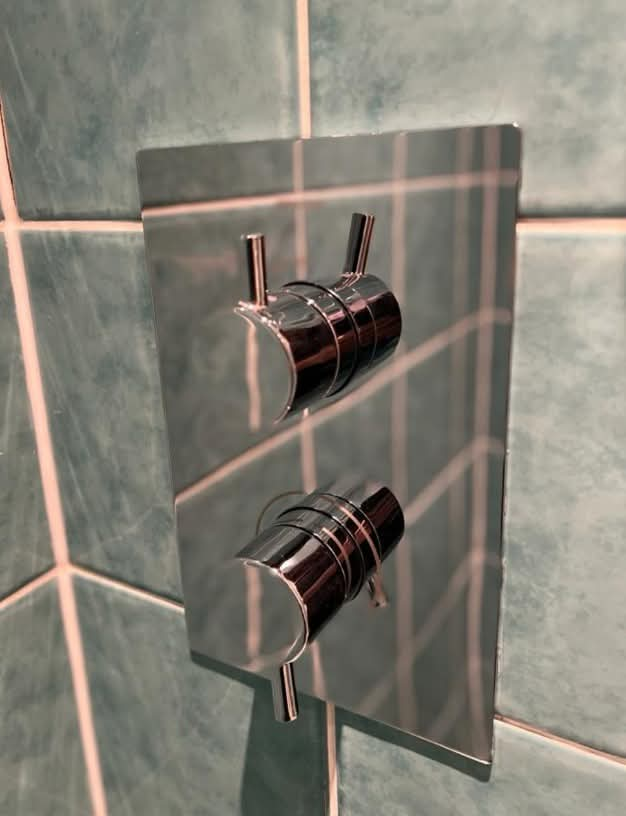
Concealed Shower Valve on Shower Wall
- Concealed Valve: A designer-style statement piece. With all the controls mounted externally, it’s easy to switch between two water outlets—like an overhead shower and a handheld showerhead. Great for larger bathrooms where a bit of extra detail on the wall adds to the aesthetic.
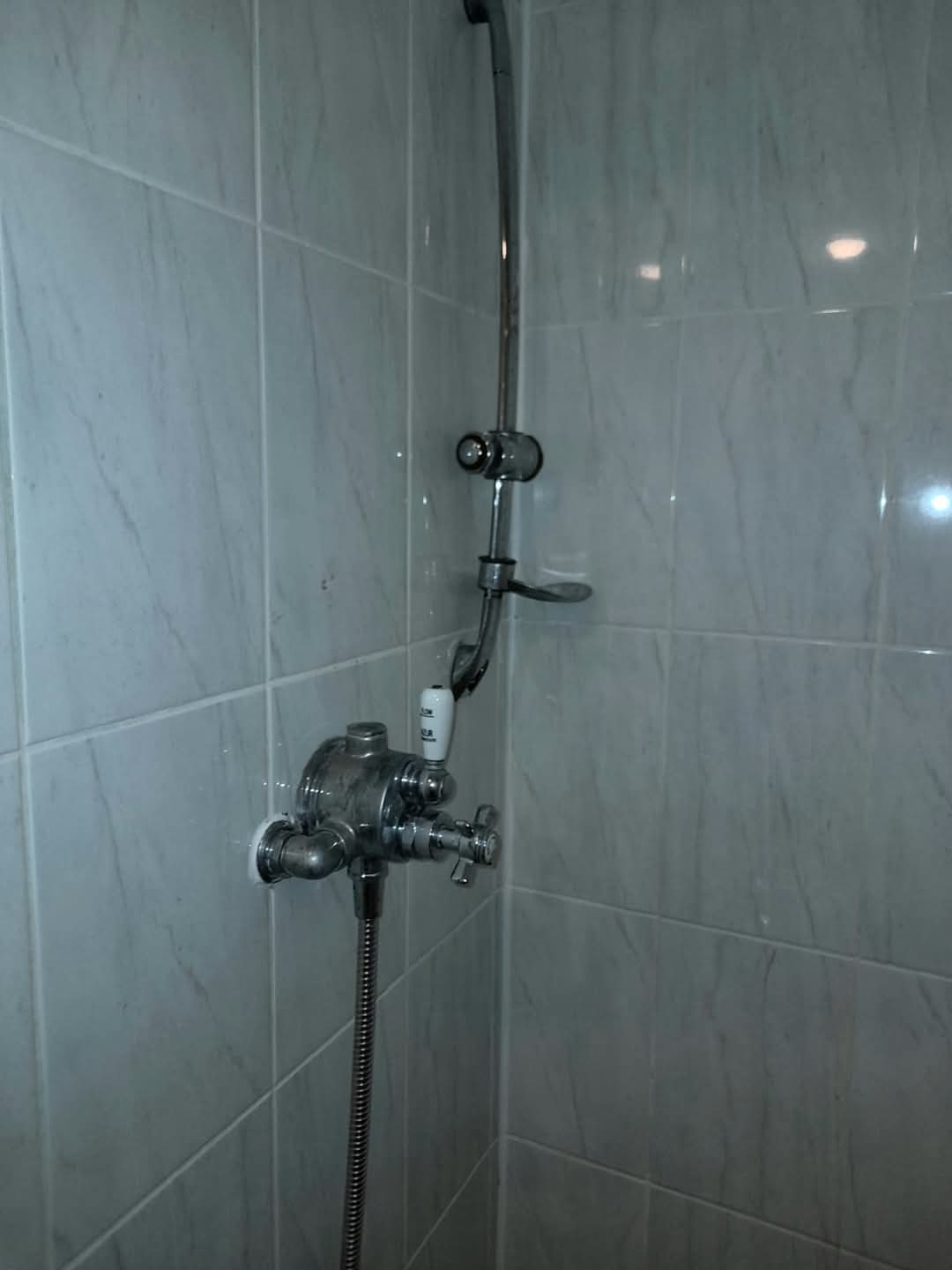
Old exposed thermostatic shower valve
- Traditional Valve: Perfect for period-style bathrooms. With elegant lever and cross handles, these valves blend vintage charm with modern thermostatic functionality. Think of them as a stylish mix of bar and exposed valve designs.
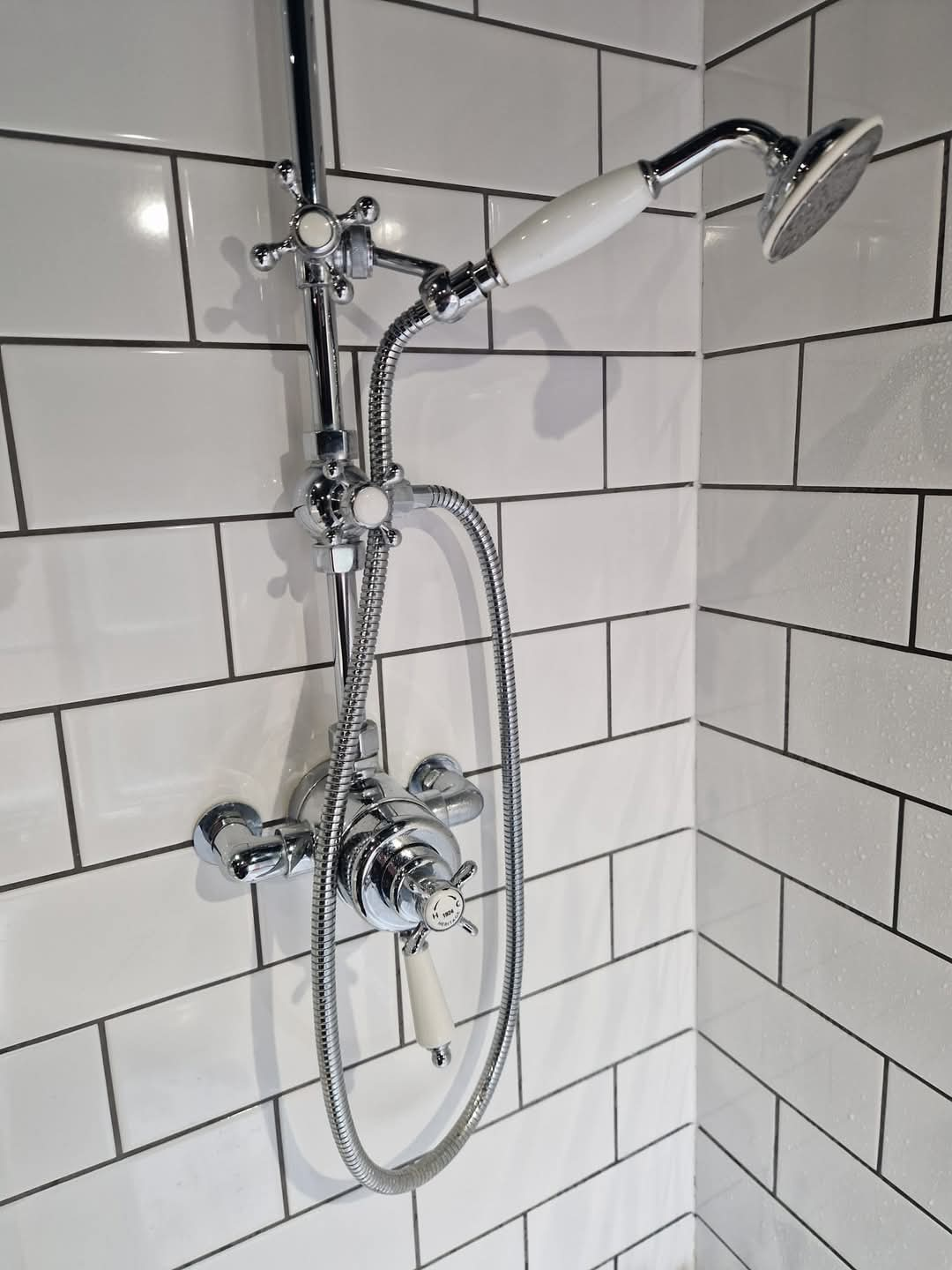
Traditional Exposed Shower Valve
Summary Of Thermostatic
Shower Benefits
Thermostatic showers offer a hassle-free, comfortable, and safe showering experience. Here’s why they’re a great choice:
| Benefit | Description |
| Consistent Water Temperature | No more sudden hot or cold surprises! The shower automatically adjusts to maintain your chosen temperature, even if someone else uses water elsewhere in the house. |
| Enhanced Safety Features | Perfect for families with young children or elderly users, thermostatic showers have built-in anti-scald protection. Most models include a safety button, typically set at 38°C, preventing the water from getting too hot unless deliberately adjusted. |
| Better Control and Comfort | With a single easy-to-use control, you can set your ideal temperature and enjoy a steady, comfortable shower every time. |
| Stylish and Versatile Options | Available in various designs, from sleek concealed valves to classic traditional styles, there’s a thermostatic shower to suit every bathroom. |
| Energy and Water Efficiency | By maintaining a steady temperature, thermostatic showers help reduce water waste and energy consumption compared to constantly adjusting a manual mixer. |
What Is The Best Thermostatic Shower To Get?
The best thermostatic shower for your home depends on your style, preferences, and budget. Here’s what to consider when choosing one:
Traditional vs. Contemporary Styles:
If you have a traditional-style bathroom with Victorian or Edwardian-style taps, finding a matching thermostatic bath shower mixer can be tricky. While more manufacturers are now offering traditional options, they’re still not as common as contemporary designs - and they often come with a higher price tag.
For a traditional thermostatic shower valve, however, you’ll find a wider range of options, though pricing can vary significantly. Budget-friendly models are available, but at the high end, luxury brands like Lefroy Brooks offer premium brassware, with prices starting around £1,000 for a shower valve alone!
On the other hand, if you prefer a modern, contemporary look, you’ll have plenty of options at various price points. Contemporary thermostatic showers are widely available, with styles ranging from sleek concealed valves to bar valves and exposed designs.
Top Recommended Brands:
If you’re looking for quality and reliability, these two manufacturers come highly recommended:
- Aqualisa (UK) – A well-regarded British brand based in Westerham, Kent, known for its innovative designs and excellent build quality.
- Grohe (Germany) – A trusted German brand with a reputation for durability, precision engineering, and stylish designs.
Both brands offer high-quality products with generous 5+ year warranties, giving you peace of mind with your purchase.
Top Tip: If you're after a traditional look, expect a more limited range and a premium price tag, especially for bath shower mixers. For contemporary styles, you’ll have a much wider selection at different price points. Either way, sticking with reputable brands like Aqualisa and Grohe ensures you're getting a high-quality, long-lasting thermostatic shower.
How To Fit A Thermostatic Shower
While it may seem a simple swap, installing a thermostatic shower requires precise plumbing knowledge to ensure correct water pressure, leak-free connections, and proper calibration. Therefore, we would always recommend using a professional for the job to ensure safe installation, avoid costly mistakes, and guarantee compliance with both building regulations and manufacturer guidelines. However, for educational purposes, here are the general steps a professional plumber would follow:
- 1.) Turn off water supply: Shut off the mains water supply and drain any remaining water from the system.
- 2.) Prepare the pipework: Ensure hot and cold-water pipes are correctly positioned and at the right distance apart. Adjust pipework if necessary.
- 3.) Mark and drill fixings: Measure and mark where the shower valve will be mounted. Drill holes and fit wall fixings securely.
- 4.) Install the shower valve: Connect the hot and cold-water feeds to the thermostatic valve, ensuring correct orientation. Ensure a watertight seal.
- 5.) Secure the valve: Fix the valve to the wall, ensuring it's level and firmly in place.
- 6.) Connect the shower kit: Attach the riser rail, showerhead, and hose as per manufacturer instructions.
- 7.) Test for leaks: Turn the water supply back on and check all connections for leaks.
- 8.) Adjust and set temperature: Calibrate the thermostat to ensure it delivers the correct temperature, typically set at 38°C with an override button for hotter water.
- 9.) Final check: Ensure smooth operation, stable water temperature, and secure fittings before completing the job.
Whether you need a shower repair, or you are thinking of updating your mixer shower to a new thermostat variety, the Maintracts team would be happy to help. Our team of fully qualified plumbers with a wealth of in-depth knowledge and experience respond to enquiries quickly and provide quality plumbing repairs without a call out charge. If you are based in our service area, give us a call at your convenience and we’ll do the rest!

